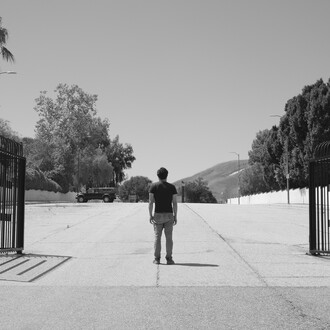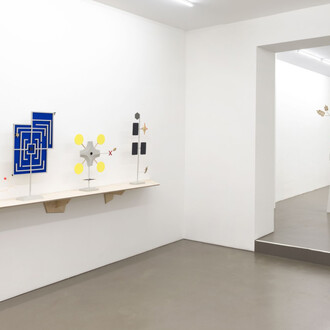Julian Irlinger’s third solo exhibition at Galerie Thomas Schulte, Sleepwalkers, presents an animated film alongside paper sculptures and graphic works.
The animation The curtain of time (2025) pans through an office interior where architects and urban planners are either sleepwalking or lying asleep at their desks. While no one is working inside, cranes outside move mechanically back and forth as part of an ongoing construction project—a cityscape suspended between repetition, reinvention, erasure and preservation. Models of modernist landmarks are replaced by timber-frame structures, reflecting the shift from postwar modernism toward historical reconstruction that has shaped German cities in recent decades.
The hypnotic, rhythmic movements of certain figures and objects seem to measure time in intangible ways: in breath, in water dripping from a cooler, smoke rising from a lit cigarette, or a projector’s flickering beam. In contrast to its visual order—drawing on mid-century animation aesthetics—the film’s soundscape forms a wandering, untamed acoustic layer that disrupts the cyclical progression.
The work–commissioned by Portikus, Frankfurt/Main–follows the format of traditional shorts that once preceded feature films in movie theaters. In contrast, the film is conceived as a seamless loop and employs the historical technique of cel animation, with individual frames hand-drawn onto transparent celluloid sheets, photographed, and compiled into sequences to create the illusion of movement.
Paper lanterns, like those crafted by children to carry through the streets on St. Martin’s Day, hold both festive and educational significance. Irlinger’s lanterns take the form of architectural models—timber-frame houses, social housing blocks, and modernist villas. Some display cut-outs reminiscent of mid-century modern design. Suspended and floating, the delicate black-paper structures are dimly lit and feature windows in red, blue, yellow, and green, transforming the space into an ethereal procession of light.
In some collages, shop windows display goods and services that appear as relics of a bygone era. In others, fragments of urban life are constructed in solid colours and bold shapes, exploring the tension between foreground and background.
What persists throughout the exhibition is a phantom presence: the mid-century modern period as a lens through which to consider how cultural narratives are constructed and circulate in visual form, and how, over time, they are taken up as instruments of learning or belief.
















